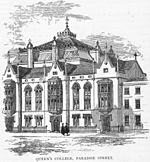Augustus Volney Waller facts for kids
Augustus Volney Waller was an important British scientist who studied how the body works, especially the nervous system. He was born on December 21, 1816, and died on September 18, 1870. He is best known for discovering how nerve fibers break down when they are cut off from their main nerve cell. This process is now called Wallerian degeneration, named after him.
A Look at Waller's Life
Augustus Volney Waller was born in Kent, England, in 1816. His father passed away when Augustus was young. He spent some of his early years in Nice, France. When he returned to England, he lived with doctors and was raised as a vegetarian until he was 18.
Waller studied medicine in Paris, France. He earned his medical degree in 1840. The next year, he became a licensed doctor in London. He started his own medical practice in Kensington.
He soon became a successful doctor. But he was also very interested in scientific research. After publishing two important papers in 1849 and 1850, he was chosen to be a Fellow of the Royal Society in 1851. This is a very high honor for scientists in Britain.
After this, Waller decided to stop being a general doctor. He moved to Bonn, Germany, to focus completely on his scientific studies. There, he worked with another scientist, Professor Julius Ludwig Budge. They published more important papers together.
For his work, Waller received the Monthyon prize from the French Academy of Sciences twice, in 1852 and 1856. The Royal Society also gave him a special medal in 1860. This was to recognize his important discoveries and new ways of studying the body.
In 1856, Waller moved to Paris to continue his research. However, he became ill and was unwell for about two years. He then returned to England. In 1858, he became a professor of physiology at Queen's College, Birmingham. He also worked as a doctor at the hospital there.
But his health problems continued, especially with his heart. He decided to retire and moved to Bruges, Belgium, and then to Switzerland to rest.
Waller's Discoveries and Work
In 1868, with better health, Waller moved to Geneva, Switzerland. He planned to work as a doctor there. He quickly became a member of a local science society. In 1869, he visited London to give a special lecture to the Royal Society. He then returned to Geneva, where he sadly died suddenly from a heart condition on September 18, 1870.
Waller made several key discoveries about the nervous system.
- He showed how nerve fibers break down after being cut. This is called Wallerian degeneration. It helped scientists understand how nerves repair themselves or don't.
- He also found a special area in the spinal cord called the cilio-spinal centre. This center helps control things like pupil size.
- He studied how blood vessels get narrower, a process called vasoconstrictor action.
- He developed a new way to study nerve paths. This method involved cutting nerves and observing how they changed. This helped map out how nerve signals travel in the body.
- He also observed how white corpuscles (a type of blood cell) can move out of tiny blood vessels.
Many of Waller's most important scientific papers were published in well-known journals. His discovery of Wallerian degeneration was described in a paper from 1851. His work on the cilio-spinal center was done with Professor Budge and published in the same year.
Waller's Family
In 1842, Augustus Waller married Matilda Walls. They had one son, Augustus Desiré Waller, who also became a famous physiologist (a scientist who studies how living things work). They also had two daughters.



